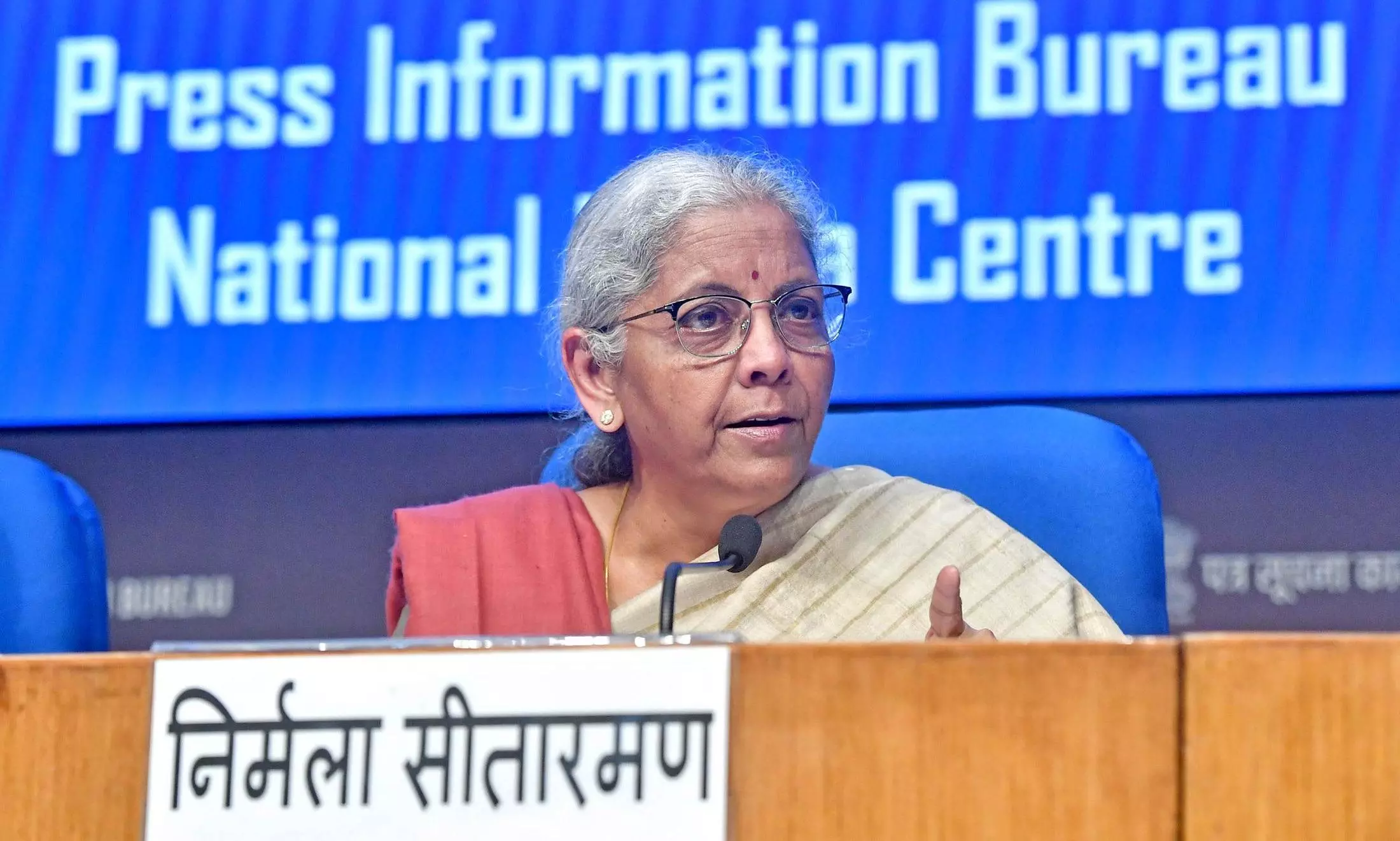Budget 2025: What's in it for logistics?
Finance minister announced a Maritime Development Fund (MDF) with a corpus of ₹25,000 crore that will be set up for long-term financing for the maritime industry.

Union Minister for Finance and Corporate Affairs Nirmala Sitharaman addressing a Post Budget Press Conference at National Media Centre, in New Delhi on February 01, 2025. (Photo: PIB)
Finance Minister Nirmala Sitharaman presented the Union Budget 2025-26 in Lok Shaba on February 1, 2025, and has positively surprised the logistics industry with measures to fuel urban consumption, strengthen MSME manufacturing, build maritime infrastructure, and promote seamless trade.
For instance, Chief Executive Officer of Accex Supply Chain Samarnath Jha points out that uplifting consumption seems to be the primary theme of this budget and “that is highly welcome,” he said.
Boost for urban consumption
In fact, the budget proposed new direct tax slabs so that no income tax is needed to be paid for total income up to ₹ 12 lakh per annum.
Chief Financial Officer of Allcargo Group Deepal Shah also thinks that the personal tax reform will offer a strong impetus to urban consumption, thus driving demand.
“The budget has laid the framework for long-term economic growth while fuelling all the key drivers – consumption, manufacturing, infrastructure, innovation, employment, private investment etc,” he said.
Virendra D. Mhaiskar, Chairman & Managing Director of IRB Infrastructure Developers, thinks that the budget reflects a genuine commitment to spur growth by placing more money in the hands of people while sticking to fiscal prudence.
“This is a tough act but the right one to keep the country geared up to tackle global uncertainties,” he added.
Along with consumption, the budget has also put a great deal of emphasis on manufacturing particularly by MSMEs.
Push for MSME manufacturing
For instance, Prime Minister Narendra Modi pointed out that the budget has a 360-degree focus on manufacturing in his remarks on the Union Budget 2025-26. He also noted that the aim is “to strengthen entrepreneurs, MSMEs, and small businesses, creating new jobs.” He stressed that the goal was clear to ensure Indian products shine in the global market.
In fact, Sitharaman described MSMEs as the second power engine in the journey to Viksit Bharat along with agriculture, investment, and exports. MSMEs constitute 45 percent of India’s exports.
She informed that the Government will set up a National Manufacturing Mission covering small, medium and large industries for furthering “Make in India”.
The scheme is expected to facilitate employment for 22 lakh persons, generate a turnover of ₹4 lakh crore and exports of over ₹1.1 lakh crore.
The increased credit limits and expanded classification criteria for MSMEs are essential steps toward unlocking the sector’s full potential to solidify India’s role as a global manufacturing and export powerhouse, says, Regional Director APAC of Achilles Information Smitha Shetty.
“The enhanced credit guarantee cover will provide much-needed financial support, allowing MSMEs to scale operations and drive innovation. Additionally, the government’s continued support for cotton farming and textile sector development will strengthen supply chains, ensuring a robust and inclusive economic landscape,” she said.
Rampraveen Swaminathan, Managing Director and CEO of Mahindra Logistics believes that the National Manufacturing Mission will further accelerate domestic production, fuelling 'Move in India' - a vision for the seamless movement of cargo across the country.
“The Union Budget reinforces India's position as one the fastest-growing major economies, bolstering the road-map for overall growth in consumption and infrastructure,” he added.
Targeted sectoral initiatives under the National Manufacturing Mission underscore the government’s ambition to create a resilient domestic production ecosystem, according to the Chief Executive Officer and Managing Director of DP World Middle East North Africa, and India Subcontinent Rizwan Soomar.
“These measures will not only boost exports but also generate employment opportunities,” he said.
Soomar also believes that the budget will significantly enhance manufacturing competitiveness with its focus on the development of maritime infrastructure, domestic air connectivity, development of dedicated rail freight corridors (DFCs) and large-scale port modernisation.
Financing Indian-flagged ships
For instance, Sitharaman announced a Maritime Development Fund (MDF) with a corpus of ₹25,000 crore that will be set up for long-term financing for the maritime industry.
“This will be for distributed support and promoting competition. This will have up to 49 percent contribution by the government, and the balance will be mobilised from ports and the private sector,” she said.
This fund will directly benefit in financing for ship acquisition. It aims at boosting Indian flagged ships' share in the global cargo volume up to 20 percent by 2047.
The Indigenous fleet will reduce the dependability of foreign ships, improve the balance of payment and secure the strategic interests of the country.
With improved shipbuilding capabilities, India can expand its shipping fleet, reduce dependency on foreign vessels, and lower logistics costs according to Founder & Managing Director at Jane Solutions Leo Peter Charles.
“This will particularly benefit fisheries and agri-export sectors, ensuring faster, more cost-effective global trade. Strengthening domestic shipbuilding also supports port infrastructure and coastal connectivity, boosting India’s trade competitiveness worldwide,” he said.
By 2030, MDF is aiming at generating up to ₹1.5 lakh crore investment in the shipping sector.
Speaking on the initiatives, Shipping Minister Sarbananda Sonowal said, “A key highlight is our ministry’s development of new shipbuilding clusters of 1.0 to 1.2 Million Gross Tonnage (GT) each. By leveraging the Public-Private Partnership (PPP) model, the scheme is designed to attract private investment, promote modernisation, and advance green technologies.”
“These efforts will enhance India’s global competitiveness, drive sustainable growth, and solidify its position as a leading global maritime hub,” he added.
However, not everybody is positive about the outlook. Founder and CEO of MatchLog Solutions Dhruv Taneja believes that expanding shipbuilding capacity and setting up a ₹25,000 crore Maritime Development Fund is important, but without solving inefficiencies in container movement, intermodal logistics, and supply chain integration, infrastructure growth alone won’t drive meaningful progress.
“Reducing empty miles, improving cargo transitions, and integrating digital freight solutions must be a priority to make these investments effective,” he said.
Also, under the investing in economy agenda, the finance minister informed that each infrastructure-related ministry will come up with a 3-year pipeline of projects that can be implemented in PPP mode.
“States will also be encouraged to do so and can seek support from the IIPDF (India Infrastructure Project Development Fund) scheme to prepare PPP proposals,” she said.
An outlay of 1.5 lakh crore is proposed for the 50-year interest-free loans to states for capital expenditure and incentives for reforms.
The budget also promises that the government will facilitate the upgradation of infrastructure and warehousing for air cargo including high-value perishable horticulture produce.
MDF is not the only instance where the government pushed for private sector contribution.
Integrating with private sector
For instance, the government's push for private sector integration into PM Gati Shakti marks a significant turning point for the logistics industry. The availability of real-time infrastructure data will greatly enhance route planning, reduce transit times, and streamline freight movement, according to Varuna Group's Founder and Managing Director Vivek Juneja.
Providing private companies access to PM Gati Shakti data will also simplify project planning and strengthen public-private partnerships, according to Girish Aggarwal, Managing Director of APM Terminals Pipavav.
"Sharing PM Gati Shakti data with private players will help improve project planning and execution and minimize inefficiencies in resource utilisation," remarks Patel Engineering Managing Director Kavita Shirvaikar.
The logistics sector is expected to benefit from the budget's focus on consumption, manufacturing and infrastructure development. The government's commitment to maritime infrastructure and PPP projects will further enhance efficiency and reduce logistics costs.

Libin Chacko Kurian
Assistant Editor at STAT Media Group, he has six years of experience in business journalism covering food & beverage, nutraceuticals and now logistics. His current passion is to understand the nuances of global supply chains and their current turmoil. Outside work, he is also interested in philosophy, history, birding and travelling. Mail him: libin@statmediagroup.com Follow on LinkedIn


